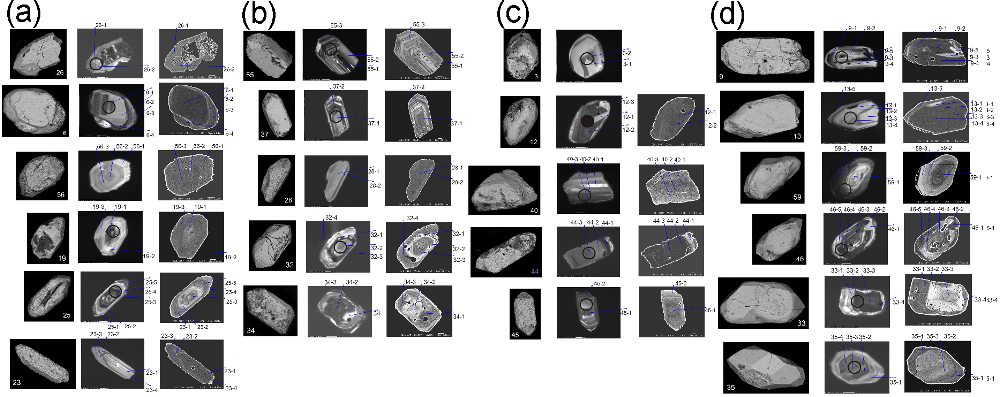RUSSIAN JOURNAL OF EARTH SCIENCES, VOL. 14, ES1001, doi:10.2205/2014ES000535, 2014

Figure 7. Micrographs of zircon grains from bed X$_1$ of bentonite ash. Zircon morphologies (left), cathodoluminescence (CL) images (center), and back-scattered electron (BSE) images (right). Arrows indicate spots analyzed for bulk composition (major components) (Table 2), and circles are spots analyzed for trace elements, including REE (Table 4). Numerals are grain numbers.
26 – Fragment of a prismatic zircon grain with traces of cataclasis and destruction of the crystal structure of the crystal core;
6 – oval grain with corroded pyramid faces, CL and BSE images showing a sharp boundary between the grain core (with fragments of coarse zoning) and heterogeneous rim (pale in CL domain is younger);
56 – short-prismatic crystal with cavernous surface and (b) zoning;
19 – fragment of a prismatic crystal with corroded pyramid and prism faces and with a zoned-sectorial inner structure;
25,
23 – long-prismatic zircon crystals with completely spongy surface sharp boundaries between the zoned cores and rims;
55,
37 – fragments of prismatic zircon grains with cavernous surface, thin zoning, and with the partial destruction of the crystal structure manifested in the form of small specks (perhaps, "cavities") seen in BSE-pale layers;
28 – fragment of a long-prismatic crystal cavernous surface and fragments of coarse zoning;
32,
34 – prismatic crystals with poorly pronounced cavernous surfaces of prisms and pyramids, prism faces are cut by cracks. In grains 32 and 34, the cores and rims are separated by a sharp boundary, seen in CL and BSE, to which inclusions (?) or cavities are restricted (seen in BSE as dark specks);
3,
12 – oval grains with a cavernous surface and with fragments of zonal-sectorial structure and a thin rim seen in CL;
40 – grain fragment with cavernous surface and (b) coarse zoning;
44 – long-prismatic zircon with (a) cavernous surface and unzoned core;
45 – prismatic crystal with cavernous surface and zoned core and a rim;
9 – prismatic crystal with a veinlet cutting across the magmatic zoning (dark in CL and pale in BSE);
13 – Fragment of a prismatic crystal with elements of zoning and thin outer rim. The boundary with the rim is lined by an object dark in CL and pale in BSE;
59 – Oval grain with extensively healed cavernous surface. CL and BSE images show a core with fragmentary primary magmatic zoning and a gradual transition to the younger rim;
46,
33 – prismatic crystals with healed minute fractures at prism faces and with the growth of newly formed pyramid faces. The CL and BSE images show intense decomposition of the crystal cores and a heterogeneous zoned structure of the rims, whose boundaries are lined with zones with inclusions or cavities, which are seen in BSE as dark specks;
35 – euhedral crystal and small fragments of a spongy structure and a crack. The CL and BSE show a core with "shadow" zoning in the newly formed coarsely zoned rim.
Citation: Grachev A. F., S. E. Borisovsky, T. F. Zinger (2014), Morphology and geochemistry of zircon in bentonite ash at the Paleocene-Eocene boundary in the Anthering Formation, Eastern Alps, Austria, Russ. J. Earth Sci., 14, ES1001, doi:10.2205/2014ES000535.
Copyright 2014 by the Geophysical Center RAS.
Generated from LaTeX source by SemTeXML, v.1.2) software package.

